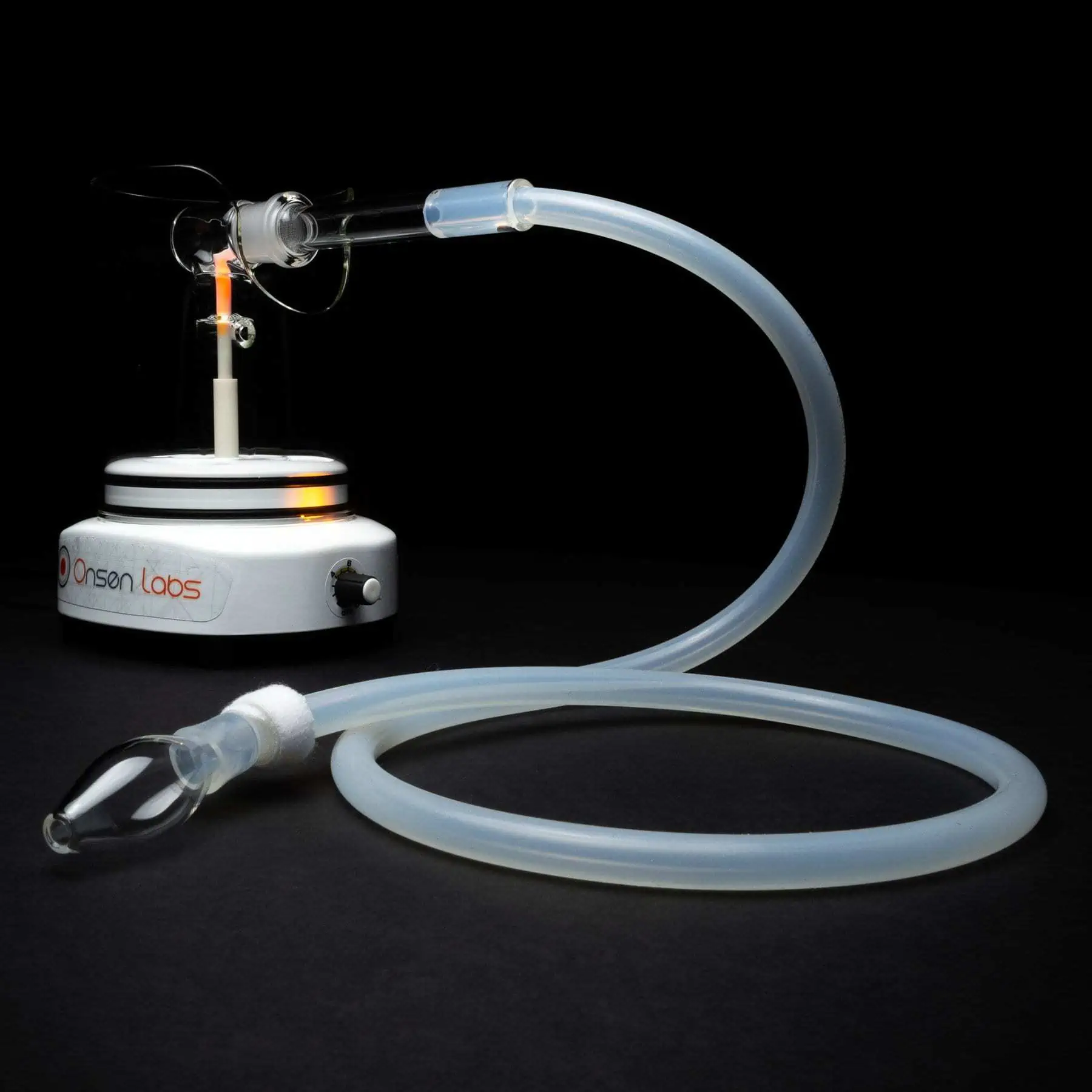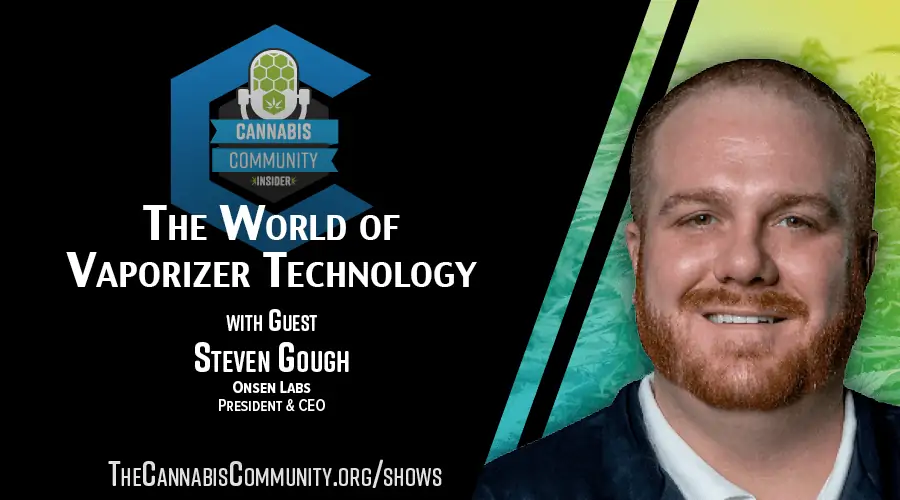Diving into the Exciting World of Dry Herb Vaporizer Technology
Join us this week on The Cannabis Community Insider with hosts Abraham Villegas and Penelope Hamilton as they learn about Vaporizer Technology from long-time community member Steven Gough, President, and CEO of Onsen Labs. Steven’s extensive experience with thermal heat technology met his love of “glass,” and the magic of the Onsen Vaporizer was created! You’ll learn what sets the Onsen Vaporizer apart from other units for a superior experience.
Table of Contents
Dry Herb Vaporizer Technology: What is it?

“A dry herb vaporizer is a heating appliance used to warm plant oils (from their raw plant material form) into gas vapors. Dry herb vaporizers help resolve issues related to combustion by offering a reduced-harm inhalation method. The user inhales and draws the vaporizers’ heated air over the plant material without igniting, releasing the active compounds in a vapor that is relatively free from the byproducts of combustion.”
Steven’s Background 00:54
- Steven’s father invented an induction heating tool in the automotive industry.
- Steven helped his father found and grow the company for over 15 years.
- Steven’s expertise is in thermal technologies and product development.
- Steven was also involved in another company that built circuit boards for Motorola and Kawasaki.
Steven’s Journey to Cannabis Vaporization 01:55
- Steven’s customer came to them with the idea of making an induction heating vaporizer.
- Induction heating is an electromagnetic technology that only works with ferrous metals.
- Over the years, Steven started thinking about getting into the cannabis industry.
- Finally, Steven moved forward and looked more into the thermal technologies for vaporization.
Induction Heating Technology 02:11
- Induction heating is a technology that heats up metal on body parts of vehicles for removing parts.
- It can heat up metal parts like the windshield, body side molding, decals or even a frozen nut cherry red in about 15 seconds.
- Induction heating is not great for cannabis vaporization.
- Induction heating is inefficient for vaporization because you’re still transferring the heat from outside.
- The heat transfer can be done much less expensive than induction heaters with a regular resistance convection heater.
- The product developed by Onsen Labs is not an induction heating product.
Convection Heating Vaporizer 05:42
- The product developed by Onsen Labs is a wind and whip vaporizer.
- It is not an induction heating product but a convection heating vaporizer.
- Convection heating vaporizer heats the air, heating the herb instead of conduction heating.
- Conduction heating is much less efficient, and it heats the herb in direct contact, leading to overheating, burning, and uneven heat.
- The walls of the wand get hot, and then the heat is transferred to the herb.
- The bulkhead of energy is created by convection heat.
Vaporization vs Smoking 07:48
- The traditional way of consuming weed is by smoking it, but when we light it on fire, it reaches about 1200-1400 degrees which destroys a lot of the plant, and causes irritation in the lungs.
- Conversely, vaporization heats the weed at a lower temperature of about a thousand degrees, boiling off the compounds instead of destroying them. This provides a fuller profile of compounds from the plant compared to combustion.
Temperature and Vaporization 08:59
- Temperature is a very specific and independent question regarding vaporization, as the temperature relates to what compounds are being released.
- The temperature range that a person will want will be very specific and independent. Even in the future, it will probably be a discussion with a doctor or primary care specialist.
- The temperature range is specific to each individual and their needs.
Temperature Zones 09:24
- Temperature zones correlate with temperature zones they’ve tested in the lab.
- Each unit is tested and provided a thermal performance certification so that the person knows what temperatures are reached inside the chamber.
- The temperature sensing is different in the product’s design because the sensor is not the same thing as organic matter that they’re heating up.
Analog Vaporizer 10:41
- The technology in the marketplace can be confusing and complicated, but analog vaporizers are simple and have temperature zones that are great for patients or any consumer.
- It can get confusing, but with an analog vaporizer, you just need to medicate, and you’ve got a range, and it’ll do.
- People get different effects at different numbers, and it’s a very specific and independent question that a person has to answer for themselves.
Vaporizer Pens 12:29
- Vaporizer pens have a thermal profile unique to the materials used in them, and the way they hold the thermal energy and release it will produce a different graph regardless of the product.
- The effects a person wants to feel or need for their health conditions are specific to them, and it’s not a one-size-fits-all.
- The disposable cannabis pens or carts can be very restrictive and almost give anxiety when pulling on them.
- There are levels to vaporizers, and people are learning more about them, including e-cigarettes, disposable cannabis pens, handheld devices, and desktop vaporizers.
Vaporizer Categories 14:46
- A vaporizer is a device that takes a liquid form of an oil and boils it into a vapor for inhalation.
- E-cigarette vaporizers are technically vaporizers.
- A vaporizer is more or less used to describe a cannabis vaporizer.
Vaporizer Materials 15:45
- The materials used in vaporizers is a focus point for improvement in the marketplace of vaporizers.
- Older pens all used a metal filament, which would get red hot and produce a metallic taste.
- Nowadays, they have more ceramic ones.
- Metals inside their hot zone get hotter and start to release byproducts.
- Inert materials like titanium are also used but is also an environmental description.
Inert Materials 17:42
- Inert materials do not react with other substances and do not produce harmful by-products.
- The element and element stand in the vaporizer should be made out of inert materials to prevent additional flavor into the herb.
- The materials are divided into two parts, the element stand and where the ceramic connects into the base.
- The product developer is responsible for designing the product specifications and how they use those materials.
Ceramic Material 17:34
- The element and element stand both pieces are made out of ceramic.
- Luminous ceramic al2o3 is an inert material.
- In a vacuum, it’s an inert material, so there is no byproduct and flavor added to the herb.
Design Specification 19:18
- It has to do with the design specifications of the product developer and how they use those materials.
- The element stand in other products was getting about 350 degrees, so the materials needed to be expanded.
- The temperature of where the ceramic connects into the base is below 100 degrees.
- The outgassing from those types of materials at that temperature is not different from what you get in your home with other products.
Ceramic vs Titanium Heating Elements 20:33
- Titanium heating elements release byproducts if heated beyond a certain point.
- Ceramic heating elements do not release any byproducts, no matter how hot they get.
- Ceramic heating elements are reinforced with design specifications to ensure safety.
- The temperature threshold for ceramic heating elements is around 3,000 degrees Fahrenheit.
- Products with ceramic heating elements are heated to 1,200-1,500 degrees Fahrenheit.
- Overheating any product can cause it to release harmful byproducts.
Flavorful Vaporization 22:51
- Vaporization produces a different flavor compared to smoking.
- Dry herb vaporizers don’t destroy low boiling compounds like beta-pinene, giving cannabis a more flavorful taste.
- Different terpenes in cannabis produce different tastes and flavors.
- Vaporization allows users to explore and play with different temperatures to tailor their experience.
- Vaporization produces a subtle, gradual increase in high, rather than hitting a wall like smoking or dabbing.
- New users should start with a dry herb vaporizer and go low and slow to avoid overdoing it.
Inhalation Safety 22:06
- There needs to be more study on the long-term effects of inhaling and consuming fumes from heated metals.
- There are anecdotal cases of health concerns about inhaling fumes from heated metals.
- Vaporizers with ceramic heating elements eliminate the risk of inhaling harmful byproducts.
- Patients should look for products that prioritize safety and avoid devices that can overheat metals and produce harmful gases and fumes.
About Onsen Labs 26:44
- Onsen Labs is a company that works on vaporizer technology.
Onsen Labs’ journey 26:46
- Steven has been working at Onsen Labs for three years.
- Steven has been working on the company and its brain from its development to where they are today.
- The interviewer asks Steven where they started three years ago and where they are at today.
- Steven mentions they are moving to a distribution model due to the PACT Act passed in December.
- The PACT Act affects their ability to ship vaporizers directly to consumers, so they are setting up distribution to sell through a high sales volume.
The PACT Act 27:04
- The PACT Act was written and intended for e-cigarette vaporizers, but it was written so vaguely that it affects all types of vaporizers.
- Steven mentions that the PACT Act is a double-edged sword, it’s good and evil.
- They are now moving to a distribution model and setting up distribution due to the PACT Act affecting their ability to ship vaporizers directly to consumers.



